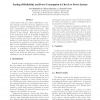Free Online Productivity Tools
i2Speak
i2Symbol
i2OCR
iTex2Img
iWeb2Print
iWeb2Shot
i2Type
iPdf2Split
iPdf2Merge
i2Bopomofo
i2Arabic
i2Style
i2Image
i2PDF
iLatex2Rtf
Sci2ools
ISQED
2002
IEEE
2002
IEEE
Trading off Reliability and Power-Consumption in Ultra-low Power Systems
Critical systems like pace-makers, defibrillators, wearable computers and other electronic gadgets have to be designed not only for reliability but also for ultra-low power consumption due to limited battery life. This paper explores architecture, logic and circuit level approaches to this tradeoff. Fault tolerance techniques at the architecture level can be broadly classified into spatial or temporal redundancy. Using an example of counters (Binary and Gray) we show that temporal redundancy is best suited for these ultra-low power and low performance systems as it consumes 30% less power than an area redundant technique. Circuit techniques allow power-reliability tradeoffs of about 50% in each measure. A methodology is developed based on lowlevel fault simulation using SPICE, which allows detailed circuit models for both power consumption and reliability in current and future CMOS technology.
| Added | 15 Jul 2010 |
| Updated | 15 Jul 2010 |
| Type | Conference |
| Year | 2002 |
| Where | ISQED |
| Authors | Atul Maheshwari, Wayne Burleson, Russell Tessier |
Comments (0)

